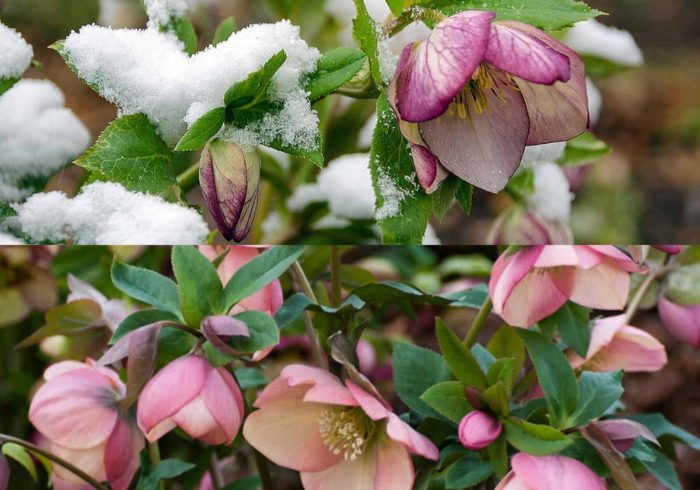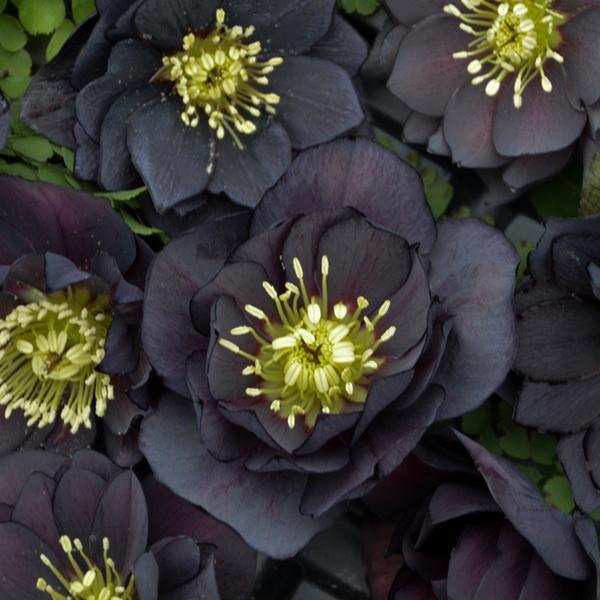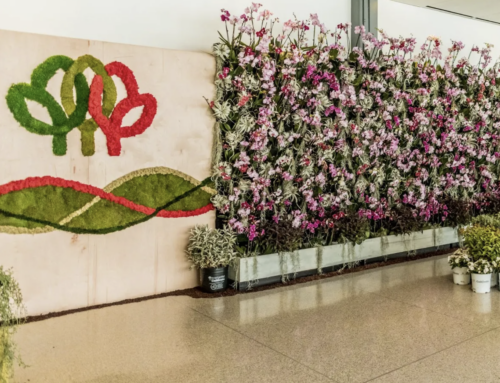In past blog postings, we have given accolades to Primrose, Pansy (Viola), and Ornamental Kale and Cabbage. Those exceptional plants exhibit steadfast perseverance through cold and snow. Though planted in both fall and spring, I considered those three most effective in carrying color through autumn and into winter. Hellebores, another sturdy cold-hardy perennial, is a stronger performer in the spring. They are also referred to as Lenten Rose from the early spring blooms that coincide with the season of Lent.
The flowers can bring pockets of color to a dull, gray landscape when many plants are still sleeping. In Michigan and other parts of the North, Hellebores can be unstoppable, as we have witnessed them bloom through the snow.
A Flowering Perennial that is Evergreen through Winter – Really?

…AND in the Spring!
Unlike other perennials, the large palmate leaves of Hellebores are almost always evergreen, truly an under-rated feature. In some seasonal settings, they may be the only perennial plant showing green in the garden. As for Hellebores in the north, we just have to assume they remain evergreen in winter, somewhere buried beneath the snow.
Many years ago, when I first encountered the Hellebores, curiosity got the best of me, and I had to touch and rub those leaves through my fingers. Surprisingly the leaves are waxy and leathery tough. This textural quality enables Hellebores to handle the woes of winter, especially damage from critter feeding. To ask a plant (assuming you’re normal and talk to plants) to remain viable through winter when many surrounding plants are dormant or defoliated is asking a lot. Being the lone green species can be a beacon to rabbits, mice, and especially deer. Hellebores resist them all. To date, I’ve never seen or heard of pests (mammals that is) feeding on Hellebores, whether it’s their coarse texture or the poisonous leaves, animals leave it alone.
Resistant to Deer and Rabbits – they just walk on by.

Photo: Costa Farms
It seemed for many years flower color for Hellebores was limited to white, cream, and even just green. That sounds like a weak selection, yet as horticulturists, many of us didn’t seem to mind. Finding a plant like a Hellebore with its unique qualities, well, we were just tickled to have it.
That has all changed now, that is color choices. Hellebores have been strategically bred and developed with flowers coming in a glorious assortment of white, yellow, green, red, various shades of purple and pink. One flower color called “black,” but I suspect it is a deep, dark purple.

Photo: Plant Delights Nursery, Inc.
Finally, a feature that doesn’t get the recognition it deserves is the ability of Hellebores to become a groundcover. By Divine design, plants naturally procreate, drop seeds, and as the Bible says, go forth and multiply. Some Hellebore varieties read and dutifully follow scripture and do just that. For those pristine (I’m refraining from saying anal) gardeners who dislike any plant that doesn’t stay in the place where it was planted, the idea of allowing Hellebores to naturalize and spread is probably not for you. Given a woodland setting or forest edge, Hellebores can be the right plant for the right place. I have come upon large, beautiful Hellebore groupings. They were filled in beneath shade trees and forming groundcover beds that rival pachysandra, vinca or English Ivy. As for light levels, in the north, I’ve had success in the sun and in shade. But – in general, Hellebores are best in part-sun and shade.
-Rob McCartney, Horticulturist
Please feel free to contact me with any questions or for more info at:
Connect with us on social media!
Instagram | Facebook | Twitter | Website



